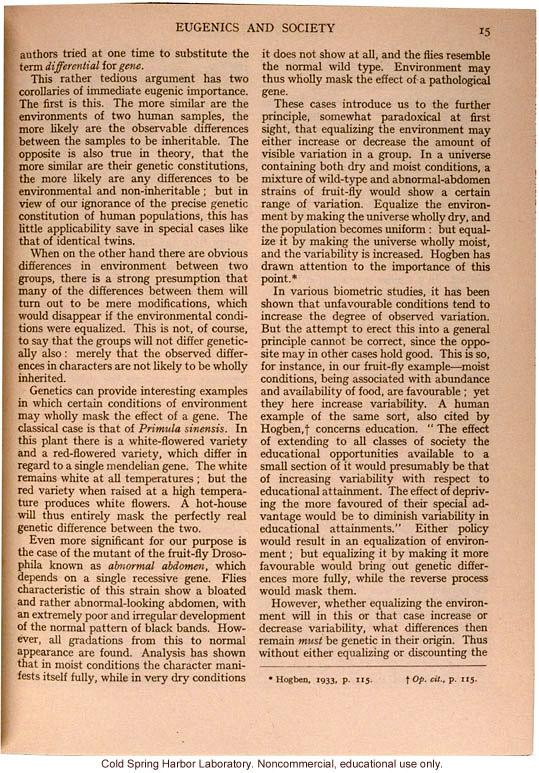Eugenics and Society 15
authors tried at one time to substitute the term [italics]differential[end italics] for [italics]gene[end italics].
This rather tedious argument has two corollaries of immediate eugenic importance. The first is this. The more similar are the environments of two human samples, the more likely are the observable differences between the two samples to be inheritable. The opposite is also true in theory, that the more similar are their genetic constitutions, the more likely are any differences to be environmental and non-inheritable; but in view of our ignorance of the precise genetic constitution of human populations, this has little applicability save in special cases like that of identical twins.
When on the other hand there are obvious differences in environment between two groups, there is a strong presumption that many of the differences between them will turn out to be mere modifications, which would disappear if the environmental conditions were equalized. This is not, of course, to say that the groups will not differ genetically also: merely that the observed differences in characters are not likely to be wholly inherited.
Genetics can provide interesting examples in which certain conditions of environment may wholly mask the effect of a gene. The classical case is that of [italics]Primula sinensis[end italics]. In this plant there is a white-flowered variety and a red-flowered variety, which differ in regard to a single mendelian gene. The white remains white at all temperatures; but the red variety when raised at a high temperature produces white flowers. A hot house will thus entirely maks the perfectly real; genetic difference between the two.
Even more significant for our purpose is the case of the mutant of the fruit-fly Drosophila known as [italics]abnormal abdomen[end italics], which depends on a single recessive gene. Flies characteristic of this strain show a bloated and rather abnormal-looking abdomen, with an extremely poor and irregular development of the normal pattern of black bands. However, all gradations from this to normal appearance are found. Analysis has shown that in moist conditions the character manifests itself fully, while in very dry conditions it does not show at all, and the flies resemble the normal wild type. Environment may thus wholly mask the effect of a pathological gene.
These cases introduce us to the further principle, somewhat paradoxical at first sight, that equalizing the environment may either increase or decrease the amount of visible variation in a group. In a universe containing both dry and moist conditions, a mixture of wild-type and abnormal-abdomen strains of fruit-fly would show a certain range of variation. Equalize the environment by making the universe wholly dry, and the population becomes uniform: but equalize it by making the universe wholly moist, and the variability is increased. Hogben has drawn attention to the importance of this point.*
In various biometric studies, it has been shown that unfavourable conditions tend to increase the degree of observed variation. But the attempt to erect this into a general principle cannot be correct, since the opposite may in other cases hold good. This is so, for instance, in our fruit-fly example - moist conditions, being associated with abundance and availability of food, are favourable; yet they here increase variability. A human example of the same sort, also cited by Hogben,[dagger] concerns education. "The effect of extending to all classes of society the educational opportunities available to a small section of it would presumably be that of increasing variability with respect to educational attainment. The effect of depriving the more favoured of their special advantage would be to diminish variability in educational attainments" Either policy would result in an equalization of environment; but equalizing it by making it more favourable would bring out genetic differences more fully, while the reverse process would mask them.
However, whether equalizing the environment will in this or that case increase or decrease variability, what differences then remain [italics]must[end italics] be genetic in their origin. Thus without either equalizing or discounting the
[hairline rule across column]
[footnote text] *Hogben, 1933, p.115. [dagger] [italics]Op. cit.,[end italics] p. 115.
[end]


